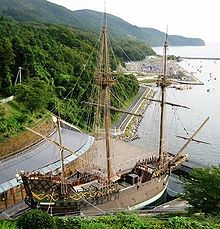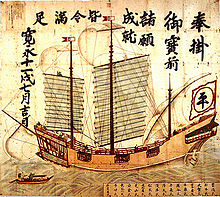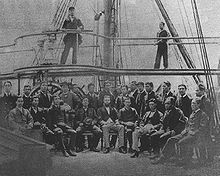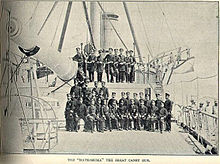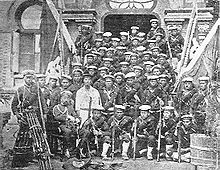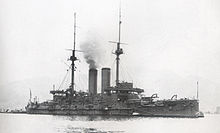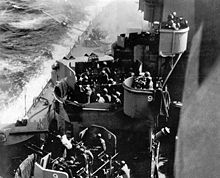- Imperial Japanese Navy
-
Imperial Japanese Navy
(IJN)
大日本帝國海軍
(Dai-Nippon Teikoku Kaigun)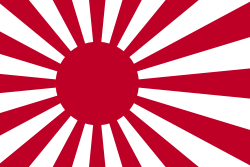
The ensign of the Imperial Japanese Navy and Japan Maritime Self-Defense Force.Active 1869–1947 Country Empire of Japan Allegiance Empire of Japan Branch Combined Fleet
Imperial Japanese Navy Air Service
Imperial Japanese Navy Land ForcesType Navy Engagements Taiwan Expedition of 1874
First Sino-Japanese War
Russo-Japanese War
World War I
Second Sino-Japanese War
World War IICommanders Notable
commandersIsoroku Yamamoto
Tōgō Heihachirō
Itoh Sukeyuki
Prince Fushimi Hiroyasu
and many othersInsignia Identification
symbol
Imperial Seal of Japan and Seal of the Imperial Japanese NavyThe Imperial Japanese Navy (IJN) (Kyūjitai: 大日本帝國海軍 Shinjitai: 大日本帝国海軍
 Dai-Nippon Teikoku Kaigun (help·info) or 日本海軍 Nippon Kaigun, literally Navy of the Greater Japanese Empire) was the navy of the Empire of Japan from 1869 until 1947, when it was dissolved following Japan's constitutional renunciation of the use of force as a means of settling international disputes. The Japan Maritime Self-Defense Force (JMSDF) was formed after the dissolution of the IJN.[1]
Dai-Nippon Teikoku Kaigun (help·info) or 日本海軍 Nippon Kaigun, literally Navy of the Greater Japanese Empire) was the navy of the Empire of Japan from 1869 until 1947, when it was dissolved following Japan's constitutional renunciation of the use of force as a means of settling international disputes. The Japan Maritime Self-Defense Force (JMSDF) was formed after the dissolution of the IJN.[1]The Japanese Navy was the third largest navy in the world by 1920, behind the Royal Navy and United States Navy.[2] It was supported by the Imperial Japanese Navy Air Service for aircraft and airstrike operation from the fleet. It was the primary opponent of the Allies in the Pacific War.
The origins of the Imperial Japanese Navy go back to early interactions with nations on the Asian continent, beginning in the early medieval period and reaching a peak of activity during the 16th and 17th centuries at a time of cultural exchange with European powers during the Age of Discovery. After two centuries of stagnation during the country's ensuing seclusion policy under the shoguns of the Edo period, Japan's navy was comparatively backward when the country was forced open to trade by American intervention in 1854. This eventually led to the Meiji Restoration. Accompanying the re-ascendance of the Emperor came a period of frantic modernization and industrialization. The navy's history of successes, sometimes against much more powerful foes as in the Sino-Japanese war and the Russo-Japanese War, ended in almost complete annihilation during the concluding days of World War II, largely by the United States Navy (USN).
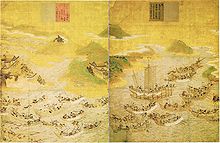 Naval battle of Dan-no-Ura in 1185.
Naval battle of Dan-no-Ura in 1185.
Origins
Main article: Naval history of JapanJapan has a long history of naval interaction with the Asian continent, involving transportation of troops between Korea and Japan, starting at least with the beginning of the Kofun period in the 3rd century.[3]
Following the attempts at Mongol invasions of Japan by Kubilai Khan in 1274 and 1281, Japanese wakō became very active in plundering the coast of the Chinese Empire.[4]
Japan undertook major naval building efforts in the 16th century, during the Warring States period, when feudal rulers vying for supremacy built vast coastal navies of several hundred ships. Around that time, Japan may have developed one of the first ironclad warships, when Oda Nobunaga, a Japanese daimyo, had six iron-covered Oatakebune made in 1576.[5] In 1588, Toyotomi Hideyoshi issued a ban on Wakō piracy; the pirates then became vassals of Hideyoshi, and comprised the naval force used in the Japanese invasion of Korea.[4]
Japan built her first large ocean-going warships in the beginning of the 17th century, following contacts with the Western nations during the Nanban trade period. In 1613, the Daimyo of Sendai, in agreement with the Tokugawa Bakufu, built Date Maru, a 500 ton galleon-type ship that transported the Japanese embassy of Hasekura Tsunenaga to the Americas, which then continued to Europe.[6] From 1604, about 350 Red seal ships, usually armed and incorporating some Western technologies, were also commissioned by the Bakufu, mainly for Southeast Asian trade.[7][8]
Seclusion and Western studies
Shōhei Maru (1854) was built from Dutch technical drawings.
Beginning in 1640, for more than 200 years Japan chose "sakoku" (seclusion), which forbade contacts with the West, eradicated Christianity, and prohibited the construction of ocean-going ships on pain of death.[9] Contacts were maintained through the Dutch enclave of Dejima however, allowing for the transfer of a vast amount of knowledge related to the Western technological and scientific revolution. This study of Western sciences, called "rangaku", also allowed Japan to remain updated in areas relevant to naval sciences, such as cartography, optics or mechanical sciences.[10] The full study of Western shipbuilding techniques resumed in the 1840s during the Late Tokugawa shogunate (Bakumatsu).[11][12]
In 1853 and 1854, U.S. Navy Commodore Matthew Perry made a demonstration of force with the newest steam warships. Perry finally obtained the opening of the country to international trade through the 1854 Convention of Kanagawa. This was soon followed by the 1858 "unequal" U.S.-Japan Treaty of Amity and Commerce, which allowed the establishment of foreign concessions, extraterritoriality for foreigners, and minimal import taxes for foreign goods.[13]
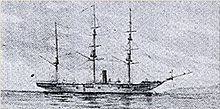 Kanrin Maru, Japan's first screw-driven steam warship, 1857
Kanrin Maru, Japan's first screw-driven steam warship, 1857
As soon as Japan agreed to open up to foreign influence, the Tokugawa shogun government initiated an active policy of assimilation of Western naval technologies. In 1855, with Dutch assistance, the Shogunate acquired its first steam warship, Kankō Maru, which was used for training, and established the Nagasaki Naval Training Center.[14] In 1857, it acquired its first screw-driven steam warship, the Kanrin Maru, which was soon used for the Japanese Embassy to the United States (1860).[14][15] In 1859, the Naval Training Center was transferred to Tsukiji in Tokyo.[16] Naval students were sent to study in Western naval schools for several years, such as the future Admiral Takeaki Enomoto (who studied in the Netherlands from 1862–1867),[16] starting a tradition of foreign-educated future leaders such as Admirals Heihachirō Tōgō and, later, Yamamoto Isoroku.[17][18]
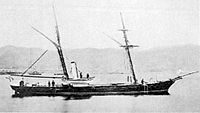 Japan's first domestically-built steam warship, launched on 02 July 1863 and completed in May 1866 edit] Japan's first domestically built modern warship
Japan's first domestically-built steam warship, launched on 02 July 1863 and completed in May 1866 edit] Japan's first domestically built modern warship
On 2 July 1863 Japan launched her first domestically built engine powered warship, the Chiyoda. Constructed by Ishikawajima of Tokyo and completed in May 1866, she was a wooden gunboat displacing 138 tons, measuring 103' in length with a 16' beam (width), and although she was equipped (rigged) as a brig the Chiyoda was powered by a single-shaft horizontal 2-cylinder trunk engine with 2 locomotive boilers. Armed with one 5.5" main gun and two smaller weapons she had a complement of 35 officers and men.
Originally built for the Shogun, Chiyoda was seized by the Japanese government in May 1868, captured by rebels later that year, then recaptured again by the Imperial Navy. Stricken from the navy roster in June 1869 Chiyoda was sold to a whaling company in 1888, serving until 1911, then scrapped shortly afterwards.[19] [20][21]
In 1865, the French naval engineer Léonce Verny was hired to build Japan's first modern naval arsenals, at Yokosuka and Nagasaki.[22] In 1867–1868, a British Naval mission headed by Captain Tracey[23] was sent to Japan to assist the development of the Navy and organize the naval school of Tsukiji.[24]
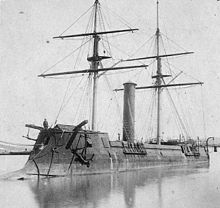 The French-built Kotetsu (ex-CSS Stonewall), Japan's first modern ironclad, 1869
The French-built Kotetsu (ex-CSS Stonewall), Japan's first modern ironclad, 1869
By the end of the Tokugawa shogunate in 1867, the Tokugawa navy was already the largest of Eastern Asia, organized around eight Western-style steam warships and the flagship Kaiyō Maru, which were used against pro-imperial forces during the Boshin War, under the command of Admiral Enomoto.[25] The conflict culminated with the Naval Battle of Hakodate in 1869, Japan's first large-scale modern naval battle, and ended with the defeat of the last Tokugawa forces and the restoration of Imperial rule.[26][27] The revolutionary French-built ironclad Kotetsu, originally ordered by the Tokugawa shogunate, was received by the Imperial side and was used decisively towards the end of the conflict.[28][29][30]
 Kanji for "Imperial Japanese Navy"
Kanji for "Imperial Japanese Navy"
From 1868, the restored Meiji Emperor continued with reforms to industrialize and militarize Japan to prevent the United States and European powers from overwhelming her. On 17 January 1868, the Ministry of Military Affairs (兵部省, also known as the Army-Navy Ministry) was established, with Iwakura Tomomi, Shimazu Tadayoshi and Prince Komatsu-no-miya Akihito as the First Secretaries.[31]
 The British-built Ryūjō was the flagship of the Imperial Japanese Navy until 1881.
The British-built Ryūjō was the flagship of the Imperial Japanese Navy until 1881.
On 26 March 1868, the first Naval Review in Japan was held in Osaka Bay, with six ships from the private domainal navies of Saga, Chōshū, Satsuma, Kurume, Kumamoto and Hiroshima participating. The total tonnage of these ships was 2,252 tons, which was far smaller than the tonnage of the single foreign vessel (from the French Navy) that also participated. The following year, in July 1869, the Imperial Japanese Navy was formally established, two months after the last combat of the Boshin War.[32]
In July 1869, the private domanial navies were abolished, and their 11 ships were added to the seven surviving vessels of the defunct Tokugawa bakufu navy to form the core of the new Imperial Japanese Navy. In 1870, the new government drafted an ambitious plan to create a Navy with 200 ships organized into ten fleets. It was abandoned within a year due to lack of resources.[33] In February 1872, the Ministry of Military Affairs was replaced by a separate Army Ministry (陸軍省) and Navy Ministry (海軍省). In October 1873, Katsu Kaishu became Navy Minister.[34]
British support
During the 1870s and 1880s, the Imperial Japanese Navy remained an essentially coastal defense force, although the Meiji government continued to modernize it. Jho Sho Maru (soon renamed Ryūjō Maru) commissioned by Thomas Glover was launched at Aberdeen, Scotland on 27 March 1869. In 1870, an Imperial decree determined that Britain's Royal Navy should be the model for development, instead of the Netherlands.[35]
From September 1870, the English Lieutenant Horse, a former gunnery instructor for the Saga fief during the Bakumatsu period, was put in charge of gunnery practice onboard the Ryūjō.[36] In 1871, the Ministry resolved to send 16 trainees abroad for training in naval sciences (14 to Great Britain, two to the United States), among which was Heihachirō Tōgō.[35] A 34-member British naval mission visited Japan in 1873 for two years, headed by Commander Archibald Douglas.[35] Later, Commander L.P. Willan was hired in 1879 to train naval cadets.[37]
First interventions abroad (Taiwan 1874, Korea 1875–76)
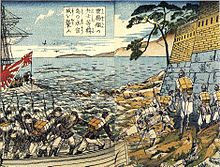 The landing of the Japanese marines from the Unyo at Ganghwa Island, Korea, in the 1875 Ganghwa Island incident.
The landing of the Japanese marines from the Unyo at Ganghwa Island, Korea, in the 1875 Ganghwa Island incident.
During 1873, a plan to invade the Korean peninsula (the Seikanron proposal made by Saigo Takamori) was narrowly abandoned by decision of the central government in Tokyo.[38] In 1874, the Taiwan expedition was the first foray abroad of the new Imperial Japanese Navy and the Imperial Japanese Army after the Mudan Incident of 1871 .[38]
Various interventions in the Korean peninsula continued in 1875–1876, starting with the Ganghwa Island incident (江華島事件) provoked by the Japanese gunboat Unyo, leading to the dispatch of a large force of the Imperial Japanese Navy. As a result, the Treaty of Ganghwa was signed, marking the official opening of Korea to foreign trade, and Japan's first example of Western-style interventionism and adoption of "unequal treaties" tactics.[39]
Soon, however domestic rebellions, the Saga Rebellion (1874) and especially the Satsuma Rebellion (1877), forced the government to focus on land warfare.[40] Naval policy, expressed by the slogan Shusei Kokubō (Jp:守勢国防, lit. "Static Defense"), focused on coastal defenses,[40] and a standing army (established with the assistance of the second French Military Mission to Japan), and a coastal Navy, leading to a military organization under the Rikushu Kaijū (Jp:陸主海従, Army first, Navy second) principle.[40]
In 1878, the Japanese cruiser Seiki sailed to Europe with an entirely Japanese crew.[23]
Further modernization (1870s)
Ships such as the Fusō, Kongō and Hiei were built in British shipyards specifically for the Imperial Japanese Navy.[41] Private construction companies such as Ishikawajima and Kawasaki also emerged around this time.
In 1883, two large warships were ordered from British shipyards. The Naniwa and Takachiho were 3,650 ton ships. They were capable of speeds up to 18 kn (33 km/h; 21 mph) and were armed with 54 to 76 mm (2 to 3 in) deck armor and two 260 mm (10 in) Krupp guns. The naval architect Sasō Sachū designed these on the line of the Elswick class of protected cruisers but with superior specifications.[42] An arms race was taking place with China however, who equipped herself with two 7,335 ton German-built battleships of (Ting Yüan and Chen-Yüan). Unable to confront the Chinese fleet with only two modern cruisers, Japan resorted to French assistance to build a large, modern fleet which could prevail in the upcoming conflict.[42]
Influence of the French "Jeune École" (1880s)
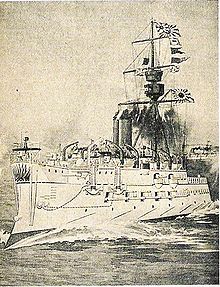 The French-built Matsushima, flagship of the Imperial Japanese Navy at the Battle of the Yalu River (1894)
The French-built Matsushima, flagship of the Imperial Japanese Navy at the Battle of the Yalu River (1894)
During the 1880s, France took the lead in influence, due to its "Jeune École" ("young school") doctrine, favoring small, fast warships, especially cruisers and torpedo boats, against bigger units.[42] The choice of France may also have been influenced by the Minister of the Japanese Navy (海軍卿), who happened to be Enomoto Takeaki at that time (Navy Minister 1880–1885), a former ally of the French during the Boshin War. Also, Japan was uneasy with being dependent on Great Britain, at a time when Great Britain was very close to China.[43]
The Meiji government issued its First Naval Expansion bill in 1882, requiring the construction of 48 warships, of which 22 were to be torpedo boats.[42] The naval successes of the French Navy against China in the Sino-French War of 1883–85 seemed to validate the potential of torpedo boats, an approach which was also attractive to the limited resources of Japan.[42] In 1885, the new Navy slogan became Kaikoku Nippon (Jp:海国日本, lit. "Maritime Japan").[44]
In 1885, the leading French Navy engineer Emile Bertin was hired for four years to reinforce the Japanese Navy and to direct the construction of the arsenals of Kure and Sasebo.[42] He developed the Sanseikan class of cruisers; three units featuring a single powerful main gun, the 320 mm (13 in) Canet gun.[42] Altogether, Bertin supervised the building of more than 20 units. They helped establish the first true modern naval force of Japan. It allowed Japan to achieve mastery in the building of large units, since some of the ships were imported, and some others were built domestically at the arsenal of Yokosuka:
- 3 cruisers: the 4,700 ton Matsushima and Itsukushima, built in France, and the Hashidate, built at Yokosuka.[43]
- 3 coastal warships of 4,278 tons.
- 2 small cruisers: the Chiyoda, a small cruiser of 2,439 tons built in Britain, and the Yaeyama, 1,800 tons, built at Yokosuka.
- 1 frigate, the 1,600 ton Takao, built at Yokosuka.[45]
- 1 destroyer: the 726 ton Chishima, built in France.
- 16 torpedo boats of 54 tons each, built in France by the Companie du Creusot in 1888, and assembled in Japan.[43]
This period also allowed Japan "to embrace the revolutionary new technologies embodied in torpedoes, torpedo-boats and mines, of which the French at the time were probably the world's best exponents".[46] Japan acquired its first torpedoes in 1884, and established a "Torpedo Training Center" at Yokosuka in 1886.[42]
These ships, ordered during the fiscal years 1885 and 1886, were the last major orders placed with France. The unexplained sinking of Unebi en route from France to Japan in December 1886, created embarrassment however.[43][47]
British shipbuilding
 The torpedo boat Kotaka (1887)
The torpedo boat Kotaka (1887)
Japan turned again to Britain, with the order of a revolutionary torpedo boat, Kotaka (considered the first effective design of a destroyer),[42] in 1887 and with the purchase of Yoshino, built at the Armstrong works in Elswick, Newcastle upon Tyne, the fastest cruiser in the world at the time of her launch in 1892.[42] In 1889, she ordered the Clyde-built Chiyoda, which defined the type for armored cruisers.[48]
Between 1882 and 1918, ending with the visit of the French Military Mission to Japan, the Imperial Japanese Navy stopped relying on foreign instructors altogether. In 1886, she manufactured her own prismatic powder, and in 1892 one of her officers invented a powerful explosive, the Shimose powder.[23]
Sino-Japanese War (1894–1895)
Main article: First Sino-Japanese WarJapan continued the modernization of its navy, especially as China was also building a powerful modern fleet with foreign, especially German, assistance, and the pressure was building between the two countries to take control of Korea. The Sino-Japanese war was officially declared on 1 August 1894, though some naval fighting had already taken place.[49]
Video footage of a naval battle during the first Sino-Japanese war[50]
The Japanese navy devastated Qing's Beiyang Fleet off the mouth of the Yalu River at the Battle of Yalu River on 17 September 1894, in which the Chinese fleet lost eight out of 12 warships. Although Japan turned out victorious, the two large German-made battleships of the Chinese Navy remained almost impervious to Japanese guns, highlighting the need for bigger capital ships in the Japanese Navy (Ting Yuan was finally sunk by torpedoes, and Chen-Yuan was captured with little damage).[49] The next step of the Imperial Japanese Navy's expansion would thus involve a combination of heavily armed large warships, with smaller and innovative offensive units permitting aggressive tactics.[51]
As a result of the conflict, under the Treaty of Shimonoseki (April 17, 1895), Taiwan and the Pescadores Islands were transferred to Japan.[52] The Imperial Japanese Navy took possession of the island and quelled opposition movements between March to October 1895, and the islands continued to be a Japanese colony until 1945. Japan also obtained the Liaodong Peninsula, although she was forced by Russia to return it to China, only to see Russia take possession of it soon after.[52]
Suppression of the Boxer rebellion (1900)
Main article: Boxer rebellionThe Imperial Japanese Navy further intervened in China in 1900, by participating together with Western Powers to the suppression of the Chinese Boxer Rebellion. The Navy supplied the largest number of warships (18 out of a total of 50), and delivered the largest contingent of troops among the intervening nations (20,840 Imperial Japanese Army and Navy soldiers, out of a total of 54,000).[53][54]
The conflict allowed Japan to enter combat together with Western nations, and to acquire first hand understanding of their fighting methods.
Russo-Japanese War (1904–1905)
Following the Sino-Japanese War, and the humiliation of the forced return of the Liaotung peninsula to China under Russian pressure (the "Triple Intervention"), Japan began to build up its military strength in preparation for further confrontations. Japan promulgated a 10-year naval build-up program, under the slogan "Perseverance and determination" (臥薪嘗胆, Gashinshōtan), in which it commissioned 109 warships, for a total of 200,000 tons, and increased its Navy personnel from 15,100 to 40,800.[55] The new fleet consisted of:[56]
- 6 battleships (all British-built)
- 8 armored cruisers (4 British-, 2 Italian-, 1 German-built Yakumo, and 1 French-built Azuma)
- 9 cruisers (5 Japanese, 2 British and 2 U.S.-built)
- 24 destroyers (16 British- and 8 Japanese-built)
- 63 torpedo boats (26 German-, 10 British-, 17 French-, and 10 Japanese-built)
One of these battleships, Mikasa, among the most powerful warships afloat when completed,[57] was ordered from the Vickers shipyard in the United Kingdom at the end of 1898, for delivery to Japan in 1902. Commercial shipbuilding in Japan was exhibited by construction of the twin screw steamer Aki-Maru, built for Nippon Yusen Kaisha by the Mitsubishi Dockyard & Engine Works, Nagasaki. The Imperial Japanese cruiser Chitose was built at the Union Iron Works in San Francisco, California.
These dispositions culminated with the Russo-Japanese War. At the Battle of Tsushima, Admiral Togo (flag in Mikasa) led the Japanese Combined Fleet into the decisive engagement of the war.[58] The Russian fleet was almost completely annihilated: out of 38 Russian ships, 21 were sunk, seven captured, six disarmed, 4,545 Russian servicemen died and 6,106 were taken prisoner. On the other hand, the Japanese only lost 116 men and three torpedo boats.[59] These victories broke Russian strength in East Asia, and triggered waves of mutinies in the Russian Navy at Sevastopol, Vladivostok and Kronstadt, peaking in June with the Potemkin uprising, thereby contributing to the Russian Revolution of 1905.
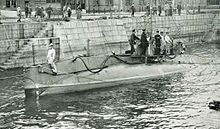 Holland 1-class submarine, the first Japanese navy submarine, purchased during the Russo Japanese War.
Holland 1-class submarine, the first Japanese navy submarine, purchased during the Russo Japanese War.
During the Russo-Japanese war, Japan also made frantic efforts to develop and construct a fleet of submarines. Submarines had only recently become operational military engines, and were considered to be special weapons of considerable potential. The Imperial Japanese Navy acquired its first submarines in 1905 from Electric Boat Company, barely four years after the U.S. Navy had commissioned its own first submarine, USS Holland. The ships were Holland designs and were developed under the supervision of Electric Boat's representative, Arthur L. Busch. These five submarines (known as Holland Type VII's) were shipped in kit form to Japan (October 1904) and then assembled at the Yokosuka, Kanagawa Yokosuka Naval Arsenal, to become hulls No1 through 5, and became operational at the end of 1905.[60]
 Satsuma, the first ship in the world to be designed and laid down as an "all-big-gun" battleship
Satsuma, the first ship in the world to be designed and laid down as an "all-big-gun" battleship
Japan continued in its efforts to build up a strong national naval industry. Following a strategy of "copy, improve, innovate",[61] foreign ships of various designs were usually analysed in depth, their specifications often improved on, and then were purchased in pairs so as to organize comparative testing and improvements. Over the years, the importation of whole classes of ships was progressively substituted by local assembly, and then complete local production, starting with the smallest ships, such as torpedo boats and cruisers in the 1880s, to finish with whole battleships in the early 20th century. The last major purchase was in 1913 when the battlecruiser Kongō was purchased from the Vickers shipyard. By 1918, there was no aspect of shipbuilding technology where Japanese capabilities fell significantly below world standards.[62]
The period immediately after Tsushima also saw the IJN, under the influence of the navalist theoretician Satō Tetsutarō, adopt an explicit policy of building for a potential future conflict against the United States Navy. Satō called for a battlefleet at least 70% as strong as that of the USA. In 1907, the official policy of the Navy became an 'eight-eight fleet' of eight modern battleships and eight battlecruisers. However, financial constraints prevented this ideal ever becoming a reality.[63]
By 1920, the Imperial Japanese Navy was the world's third largest navy and a leader in naval development:
- Following its 1897 invention by Marconi, the Japanese Navy was the first navy to employ wireless telegraphy in combat, at the 1905 Battle of Tsushima.[64]
- In 1905, it began building the battleship Satsuma, at the time the largest warship in the world by displacement, and the first ship to be designed, ordered and laid down as an "all-big-gun" battleship, about one year prior to the launching of HMS Dreadnought. However, due to a lack of material, she was completed with a mixed battery of rifles, launched on 15 November 1906, and completed on 25 March 1910.[65][66]
- Between 1903[65] and 1910, Japan began to build battleships domestically. The 1906 battleship Satsuma was built in Japan with about 80% material imported from Great Britain, with the following battleship class in 1909,[67] the Kawachi, being built with only 20% imported parts.
World War I
Main articles: Japan during World War I and Asian and Pacific theatre of World War IJapan entered World War I on the side of the Allies, against Imperial Germany and Austria-Hungary, as a consequence of the 1902 Anglo-Japanese Alliance.
 The Japanese seaplane carrier Wakamiya conducted the world's first sea-launched air raids in September 1914.
The Japanese seaplane carrier Wakamiya conducted the world's first sea-launched air raids in September 1914.
In the Battle of Tsingtao, the Japanese Navy seized the German naval base of Tsingtao. During the battle, beginning on 5 September 1914, Wakamiya conducted the world's first successful sea-launched air strikes.[68] from Kiaochow Bay.[69] Four Maurice Farman seaplanes bombarded German land targets (communication centers and command centers) and damaged a German minelayer in the Tsingtao peninsula from September to 6 November 1914 when the Germans surrendered.[70]
Concurrently, a battle group was sent to the central Pacific in August and September to pursue the German East Asiatic squadron, which then moved into the Southern Atlantic, where it encountered British naval forces and was destroyed at the Battle of the Falkland Islands. Japan seized former German possessions in Micronesia (the Mariana Islands, excluding Guam); the Caroline Islands; and the Marshall Islands), which remained Japanese colonies until the end of World War II, under the League of Nations' South Pacific Mandate.[71]
Hard pressed in Europe, where she had only a narrow margin of superiority against Germany, Britain had requested, but was denied, the loan of Japan's four newest Kongō-class battlecruisers (Kongō, Hiei, Haruna, and Kirishima), the first ships in the world to be equipped with 356 mm (14 in) guns, and the most formidable battlecruisers in the world at the time.[72]
Following a further request to contribute to the conflict, and the advent of unrestricted submarine warfare by Germany, the Imperial Navy in March 1917 sent a special force of destroyers to the Mediterranean. This force, consisting of one armoured cruiser, Akashi, as flotilla leader, and eight of the Navy's newest destroyers (Malta and efficiently protected allied shipping between Marseille, Taranto, and ports in Egypt until the end of the War. In June, Akashi was replaced by Izumo, and four more destroyers were added (Kashi, Hinoki, Momo, and Yanagi). They were later joined by the cruiser Nisshin. By the end of the war, the Japanese had escorted 788 allied transports. One destroyer, Sakaki, was torpedoed by an Austrian submarine with the loss of 59 officers and men.[73]
In 1918, ships such as Azuma were assigned to convoy escort in the Indian Ocean between Singapore and the Suez Canal as part of Japan’s contribution to the war effort under the Anglo-Japanese alliance.
After the conflict, the Japanese Navy received seven German submarines as spoils of war, which were brought to Japan and analysed, contributing greatly to the development of the Japanese submarine industry.[74]
Interwar years
In the years before World War II, the IJN began to structure itself specifically to fight the United States. A long stretch of militaristic expansion and the start of the Second Sino-Japanese war in 1937 had exacerbated tensions with the United States, which was seen as a rival of Japan.
The Imperial Japanese Navy was faced, before and during World War II, with considerable challenges, probably more so than any other navy in the world.[75] Japan, like Britain, was almost entirely dependent on foreign resources to supply its economy. To achieve Japan’s expansionist policies, IJN had to secure and protect distant sources of raw material (especially Southeast Asian oil and raw materials), controlled by foreign countries (Britain, France, and the Netherlands). To achieve this goal, she had to build large warships capable of long range.
This was in conflict with Japan's doctrine of "decisive battle" (艦隊決戦, Kantai kessen, which did not require long range),[76] in which IJN would allow the U.S. to sail across the Pacific, using submarines to weaken it, then engage the U.S. Navy in a "decisive battle area", near Japan, after inflicting such attrition.[77] This is in keeping with the theory of Alfred T. Mahan, to which every major navy subscribed before World War II, in which wars would be decided by engagements between opposing surface fleets[78] (as they had been for over 300 years). Following the dictates of Satō (who doubtless was influenced by Mahan),[79] it was the basis for Japan's demand for a 70% ratio (10:10:7) at the Washington Naval Conference, which would give Japan superiority in the "decisive battle area", and the U.S.' insistence on a 60% ratio, which meant parity.[80] Japan, unlike other navies, clung to it even after it had been demonstrated to be obsolete.
It was also in conflict with her past experience. Japan's numerical and industrial inferiority led her to seek technical superiority (fewer, but faster, more powerful ships), qualitative superiority (better training), and aggressive tactics (daring and speedy attacks overwhelming the enemy, a recipe for success in her previous conflicts). She failed to take account of the fact her opponents in the Pacific War did not face the political and geographical constraints of her previous wars, nor did she allow for losses in ships and crews.[81]
Between the wars, Japan took the lead in many areas of warship development:
- In 1921, it launched the Hōshō, the first purpose-designed aircraft carrier in the world to be completed,[82] and subsequently developed a fleet of aircraft carriers second to none.
- In keeping with its doctrine, the Imperial Navy was the first navy in the World to mount 356 mm (14 in) guns (in Kongō), 406 mm (16 in) guns (in Nagato), and the only Navy ever to mount 460 mm (18 in) guns (in the Yamato-class).[83]
- In 1928, she launched the innovative Fubuki-class destroyer, introducing enclosed dual 127 mm (5 in) turrets capable of anti-aircraft fire. The new destroyer design was soon emulated by other navies. The Fubukis also featured the first torpedo tubes enclosed in splinterproof turrets.[84]
- Japan developed the 610 mm (24 in) oxygen fuelled Type 93 torpedo, generally recognized as the best torpedo in the world, to the end of World War II.[85]
 Captain Sempill showing a Sparrowhawk to Admiral Tōgō Heihachirō, 1921.
Captain Sempill showing a Sparrowhawk to Admiral Tōgō Heihachirō, 1921.
By 1921, Japan's naval expenditure reached nearly 32% of the national budget. In 1941, the Imperial Japanese Navy possessed 10 battleships, 10 aircraft carriers, 38 cruisers (heavy and light), 112 destroyers, 65 submarines, and various auxiliary ships.[86]
Japan at times continued to solicit foreign expertise in areas in which the IJN was inexperienced, such as naval aviation. In 1918, Japan invited the French Military Mission to Japan (1918-1919), composed of 50 members and equipped with several of the newest types of airplanes to establish the fundamentals of Japanese naval aviation (the planes were several Salmson 2A2, Nieuport, Spad XIII, two Breguet XIV, as well as Caquot dirigibles). In 1921, Japan hosted for a year and a half the Sempill Mission, a group of British instructors who were able to train and advise the Imperial Japanese Navy on several new aircraft such as the Gloster Sparrowhawk, and on various techniques such as torpedo bombing and flight control.[87]
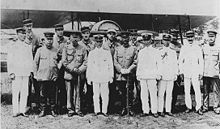 Tōgō Heihachirō with members of the French Military Mission to Japan (1918-1919) in Gifu Prefecture.
Tōgō Heihachirō with members of the French Military Mission to Japan (1918-1919) in Gifu Prefecture.
During the pre-war years, two schools of thought battled over whether the Navy should be organized around powerful battleships, ultimately able to defeat American ones in Japanese waters, or around aircraft carriers. Neither really prevailed, and both lines of ships were developed, with the result neither solution displayed overwhelming strength over the American adversary. A consistent weakness of Japanese warship development was the tendency to incorporate too much armament, and too much engine power, in comparison to ship size (a side-effect of the Washington Treaty), leading to shortcomings in stability, protection and structural strength.[88]
World War II
Main article: Imperial Japanese Navy of World War IIImperial Japanese Navy vs US Navy shipbuilding
(1937–1945, in Standard Tons Displacement)[89]IJN USN 1937 45,000 75,000 1938 40,000 80,000 1939 35,000 70,000 1940 50,000 50,000 1941 180,000 130,000 1942-45 550,000 3,200,000 The IJN of World War II was administered by the Ministry of the Navy of Japan and controlled by the Chief of the Imperial Japanese Navy General Staff at Imperial General Headquarters. In order to combat the numerically superior American navy, the IJN devoted large amounts of resources to creating a force superior in quality,[90] the objective being of "making up for quantity by means of quality".[91] Consequently, at the beginning of World War II, Japan probably had the most sophisticated Navy in the world.[92] Betting on the agile success of aggressive tactics (stemming from Mahanian doctrine and the lure of "decisive battle"), Japan did not invest significantly on defensive organization: she needed to protect her long shipping lines against enemy submarines, which she never managed to do, particularly under-investing in the vital role of antisubmarine warfare (both escort ships and escort carriers), and in the specialized training and organization to support it.[93]
IJN enjoyed spectacular success during the first part of the hostilities, but American forces ultimately managed to gain the upper hand through technological upgrades to its air and naval forces and a vastly greater industrial output.[94] Japan's reluctance to use their submarine fleet for commerce raiding and failure to secure their communications also hastened her defeat. During the last phase of the war, the Imperial Japanese Navy resorted to a series of desperate measures, including a variety of Special Attack Units (popularly called kamikaze).[95]
Battleships
Japan continued to attribute considerable prestige to battleships and endeavoured to build the largest and most powerful ships of the period. Yamato, the largest and most heavily-armed battleship in history, was launched in 1941.[96]
The second half of World War II saw the last battleship duels. In the Battle of Guadalcanal on 15 November 1942, the U.S. battleships USS South Dakota and Washington fought and destroyed the Japanese battleship Kirishima, but only after South Dakota had sustained heavy damage. In the Battle of Leyte Gulf on 25 October 1944 six battleships, led by Rear Admiral Jesse Oldendorf of the U.S. 7th Fleet, fired upon and claimed credit for sinking Vice Admiral Shoji Nishimura's battleships Yamashiro and Fusō during the Battle of Surigao Strait; in fact, both battleships were fatally crippled by destroyer attacks before being brought under fire by Oldendorf's old battleships.
Nevertheless, the Battle off Samar on 25 October 1944 during the Battle of Leyte Gulf showed battleships could still be useful. Only the indecision of Vice Admiral Takeo Kurita and the fight by American destroyers and destroyer escorts saved the American escort carriers of "Taffy 3" from destruction by the gunfire of Yamato, Kongō, Haruna, and Nagato and their cruiser escort. Miraculously for the Americans, only one escort carrier, two destroyers, and one destroyer escort were lost in this action.
Ultimately, the maturity of air power spelled doom for the battleship. Battleships in the Pacific ended up primarily performing shore bombardment and anti-aircraft defense for the carriers. Yamato and Musashi were sunk by air attacks long before coming in gun range of the American fleet.[97] As a result of the changing technology, plans for even larger battleships, such as the Japanese Super Yamato class battleship, were cancelled.
Aircraft carriers
 The Shōkaku shortly after completion in August 1941.
The Shōkaku shortly after completion in August 1941.
In the 1920s, the Kaga (originally laid down as a battleship) and a similar ship, the Akagi (originally laid down as a battlecruiser) were converted to aircraft carriers to satisfy the terms of the Washington Naval Treaty.[98] From 1935-1938, Akagi and Kaga received extensive rebuilds to improve their aircraft handling capacity.[98]
Japan put particular emphasis on aircraft carriers. The Imperial Japanese Navy started the Pacific War with 10 aircraft carriers,[99] the largest and most modern carrier fleet in the world at that time. There were seven American aircraft carriers at the beginning of hostilities, only three operating in the Pacific; and eight British aircraft carriers, of which a single one operated in the Indian Ocean. The IJN's two Shōkaku-class carriers were superior to any carrier in the world, until the wartime appearance of the American Essex-class.[100] A large number of these Japanese carriers were of small size, however, in accordance with the limitations placed upon the Navy by the London and Washington Naval Conferences.
Following the Battle of Midway, in which four Japanese fleet carriers were sunk, the IJN suddenly found itself short of fleet carriers (as well as trained aircrews), resulting in an ambitious set of projects to convert commercial and military vessels into escort carriers, such as the Hiyō. Another conversion project, Shinano, was based on an incomplete Yamato-class super battleship and became the largest-displacement carrier of World War II. The IJN also attempted to build a number of fleet carriers, though most of these projects were not completed by the end of the war. One exception being the Taihō, which was the only Japanese carrier with an armored flight deck and first to incorporate a closed hurricane bow. All three mid-war designs were sunk in 1944, with Shinano and Taiho being sunk by U.S. submarines, and Hiyo by air attacks.
Main article: Imperial Japanese Navy Air ServiceJapan began the war with a highly competent naval air force designed around some of the best airplanes in the world: the A6M Zero was considered the best carrier aircraft of the beginning of the war, the Mitsubishi G3M bomber was remarkable for its range and speed, and the Kawanishi H8K was the world's best flying boat.[101] The Japanese pilot corps at the beginning of the war were of high caliber as compared to their contemporaries around the world due to intense training and frontline experience in the Sino-Japanese War.[102] The Navy also had a competent tactical bombing force based around the Mitsubishi G3M and G4M bombers, which astonished the world by being the first planes to sink enemy capital ships underway, claiming battleship Prince of Wales and the battlecruiser Repulse.
As the war progressed, the Allies found weaknesses in Japanese naval aviation. Though most Japanese aircraft were characterized by great operating ranges, they had very little in the way of defensive armament and armor.[103] As a result, the more numerous, heavily armed and armored American aircraft were able to develop techniques that nullified the advantages of the Japanese aircraft. Although there were delays in engine development,[104] several new competitive designs were developed during the war, but industrial weaknesses, lack of raw materials and disorganization due to Allied bombing raids hampered their mass-production. Furthermore, the IJN did not have an efficient process for rapid training of aviators, as two years of training were usually considered necessary for a carrier flyer. Therefore, they were not able to effectively replace seasoned pilots lost through combat attrition following their initial successes in the Pacific campaign.[103] The inexperience of IJN pilots who were trained in the later part of the war was especially evident during the Battle of the Philippine Sea, when their aircraft were shot down in droves by the American naval pilots in what the Americans later called the "Great Marianas Turkey Shoot". Following the Battle of Leyte Gulf, the Japanese Navy increasingly opted towards deploying aircraft in the kamikaze role.
Japan's first jet-powered aircraft, the Imperial Japanese Navy's Nakajima J9Y Kikka (1945).
Towards the end of the conflict, several competitive plane designs were developed, such as the 1943 Shiden, but such planes were produced too late and in insufficient numbers (415 units for the Shiden) to affect the outcome of the war.[105] Radical new plane designs were also developed, such as the canard design Shinden, and especially jet-powered aircraft such as the Nakajima Kikka and the rocket-propelled Mitsubishi J8M. These jet designs were partially based on technology received from Nazi Germany, usually in the form of a few drawings only, Kikka being based on the Messerschmitt Me 262 and the J8M on the Messerschmitt Me 163), so Japanese manufacturers had to play a key role in the final engineering.[106] These developments also happened too late in the conflict to have any influence on the outcome. The Kikka only flew twice before the end of the war.[94]
Submarines
Main article: Imperial Japanese Navy submarines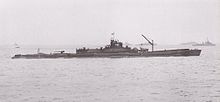 An Imperial Japanese Navy's I-400 class submarine, the largest submarine type of World War II.
An Imperial Japanese Navy's I-400 class submarine, the largest submarine type of World War II.
Japan had by far the most varied fleet of submarines of World War II, including manned torpedoes (Kaiten), midget submarines (Ko-hyoteki, Kairyu), medium-range submarines, purpose-built supply submarines (many for use by the Army), long-range fleet submarines (many of which carried an aircraft), submarines with the highest submerged speeds of the conflict (Senkou I-201), and submarines that could carry multiple bombers (World War II's largest submarine, the Sentoku I-400). These submarines were also equipped with the most advanced torpedo of the conflict, the Type 95 torpedo, a 533 mm (21 in) version of the famous 610 mm (24 in) Type 93.[107]
A plane from one such long-range fleet submarine, I-25, conducted the only aerial bombing attack on the continental United States when Warrant Flying Officer Nobuo Fujita attempted to start massive forest fires in the Pacific Northwest outside the town of Brookings, Oregon on September 9, 1942.[108] Other submarines undertook trans-oceanic missions to German-occupied Europe, such as I-30, I-8, I-34, I-29 and I-52, in one case flying a Japanese seaplane over France in a propaganda coup.[109] In May 1942, Type A midget submarines were used in the attack on Sydney Harbour and the Battle of Madagascar.
Sinking of merchant shipping,
during World War II.[110]Submarines
(number)Ships sunk
(number)Tonnage sunk
(tons)Germany 1,000 2,000 14.5 million United States 1,079 4.65 million Great Britain 493 1.5 million Japan 184 170 1 million Overall however, Japanese submarines were relatively unsuccessful.[110] They were often used in offensive roles against warships (per Mahanian doctrine), which were fast, maneuverable and well-defended compared to merchant ships. In 1942, Japanese submarines managed to sink two fleet carriers (Yorktown and Wasp), one cruiser, and a few destroyers and other warships, and damage several others (aircraft carrier Saratoga).[110] They were not able to sustain these results afterwards, as Allied fleets were reinforced and started using better anti-submarine tactics. By the end of the war, submarines were instead often used to transport supplies to island garrisons. During the war, Japan managed to sink about 1 million tons of merchant shipping (170 ships) with her 184 submarines, compared to 1.5 million tons for Britain (493 ships), 4.65 million tons for the US (1079 ships)[111] and 14.5 million tons for Germany (2,000 ships) with her 1,000 U-Boats.[110]
Early models were not very maneuverable under water, could not dive very deep, and lacked radar. Later in the war, units fitted with radar were in some instances sunk due to the ability of US radar sets to detect their emissions. For example, USS Batfish sank three such in the span of four days. After the end of the conflict, several of Japan's most original submarines were sent to Hawaii for inspection in "Operation Road's End" (I-400, I-401, I-201 and I-203) before being scuttled by the U.S. Navy in 1946 when the Soviets demanded access to the submarines as well.[108]
Special Attack Units
Main article: Japanese Special Attack UnitsAt the end of World War II, numerous Special Attack Units (Japanese: 特別攻撃隊, tokubetsu kōgeki tai, also abbreviated to 特攻隊, tokkōtai) were developed for suicide missions, in a desperate move to compensate for the annihilation of the main fleet.[95] These units included Kamikaze ("Divine Wind") bombers,[95] Shinyo ("Sea Quake") suicide boats,[112] Kairyu ("Sea Dragon") suicide midget submarines,[113] Kaiten ("Turn of Heaven") suicide torpedoes,[112] and Fukuryu ("Crouching Dragon") suicide scuba divers who would swim under boats and use explosives mounted on bamboo poles to destroy both the boat and themselves.[112] Kamikaze planes were particularly effective during the defense of Okinawa, in which about 2,000 planes were sent to sink 34 warships and damage around 364.[114]
A considerable number of Special Attack Units were built and stored in coastal hideouts for the desperate defense of the Home islands, with the potential to destroy or damage thousands of enemy warships.[112]
Imperial Japanese Navy Land Forces of World War II originated with the Special Naval Landing Forces, and eventually consisted of the following:
- Special Naval Landing Force or Rikusentai or kaigun rikusentai or Tokubetsu Rikusentai: the Japanese Marines
- The Base Force or Tokubetsu Konkyochitai provided services, primarily security, to naval facilities
- Defence units or Bobitai or Boei-han: detachments of 200 to 400 men.
- Guard forces or Keibitai: detachments of 200–500 men who provide security to Imperial Japanese Navy facilities
- Pioneers or Setsueitai built naval facilities, including airstrips, on remote islands.
- Naval Civil Engineering and Construction Units, or Kaigun Kenchiku Shisetsu Butai
- The Naval Communications Units or Tsushintai of 600–1,000 men to provide basic naval communications and also handled encryption and decryption.
- The Tokkeitai Navy military police units were part of the naval intelligence armed branch, with military police regular functions in naval installations and occupied territories; they also worked with the Imperial Japanese Army's Kempeitai military police, the Keishicho civil police and Tokko secret units in security and intelligence services.
Bases and facilities
Main article: Imperial Japanese Navy bases and facilitiesSelf-Defense Forces
 Japanese Sailors beside the Japan Maritime Self-Defense Force (JMSDF) training vessel JDS Kashima, in Pearl Harbor, May 4, 2004.
Japanese Sailors beside the Japan Maritime Self-Defense Force (JMSDF) training vessel JDS Kashima, in Pearl Harbor, May 4, 2004. Main article: Japan Maritime Self-Defense Force
Main article: Japan Maritime Self-Defense ForceFollowing Japan's surrender to the Allies at the conclusion of World War II and Japan's subsequent occupation, Japan's entire imperial military was dissolved in the new 1947 constitution which states, "The Japanese people forever renounce war as a sovereign right of the nation and the threat or use of force as a means of settling international disputes." Japan's current navy falls under the umbrella of the Japan Self-Defense Forces (JSDF) as the Japan Maritime Self-Defense Force (JMSDF).
See also
- Ministry of the Military (Ritsuryō)
- Combined Fleet
- Carrier Striking Task Force
- Naval history of Japan
- Imperial Japanese Navy Aviation Bureau
- Japanese Special Naval Landing Forces
- Imperial Japanese Navy Land Forces
- Imperial Japanese Navy Armor Units
- Tokkeitai - Navy Military Police
- Imperial Japanese Navy fuel
- List of Japanese Navy ships and war vessels in World War II
- "Strike South" Doctrine
- Fleet Faction – Navy political group
- Treaty Faction – Navy political group
- May 15 Incident – coup d'état with Navy support
- Imperial Way Faction
- Japanese nationalism
- Imperial Rescript to Soldiers and Sailors
- Imperial Japanese Naval Academy
- Admiral of the Fleet (Japan)
- Marshal (Japan)
Notes
- ^ Library of Congress Country Studies, Japan> National Security> Self-Defense Forces> Early Development
- ^ Evans, Kaigun
- ^ Early Samurai: 200-1500 AD by Anthony J. Bryant, Angus McBride p.7
- ^ a b The nature and origins of Japanese imperialism by Donald Calman p.29ff [1]
- ^ THE FIRST IRONCLADS In Japanese: [2]. Also in English: [3]: "Iron clad ships, however, were not new to Japan and Hideyoshi; Oda Nobunaga, in fact, had many iron clad ships in his fleet." (referring to the anteriority of Japanese ironclads (1578) to the Korean Turtle ships (1592)). In Western sources, Japanese ironclads are described in CR Boxer "The Christian Century in Japan 1549–1650", p122, quoting the account of the Italian Jesuit Organtino visiting Japan in 1578. Nobunaga's ironclad fleet is also described in "A History of Japan, 1334–1615", Georges Samson, p309 ISBN 0-8047-0525-9. Korea's "ironclad Turtle ships" were invented by Admiral Yi Sun-sin, and are first documented in 1592. Incidentally, Korea's iron plates only covered the roof (to prevent intrusion), and not the sides of their ships. The first Western ironclads date to 1859 with the French Gloire ("Steam, Steel and Shellfire").
- ^ Japan encyclopedia by Louis Frédéric p.293
- ^ Asia in the Making of Europe, Volume III by Donald F. Lach, Edwin J. Van Kley p.29 [4]
- ^ The military revolution: military innovation and the rise of the West, 1500-1800 by Geoffrey Parker p.110 [5]
- ^ A history of Japan by R. H. P. Mason, J. G. Caiger p.205
- ^ A history of Japan by R. H. P. Mason, J. G. Caiger p.246
- ^ Western Enterprise in Far Eastern Economic Development by G. C. Allen, Audrey G. Donnithorne p.189 [6]
- ^ Political change and industrial development in Japan by Thomas Carlyle Smith p.10 [7]
- ^ The best course available by Kei Wakaizumi, John Swenson-Wright p.332 [8]
- ^ a b Chapman Great Sailing Ships of the World by Otmar Schäuffelen p.186 [9]
- ^ Ironclad down: the USS Merrimack-CSS Virginia from construction to destruction Carl D. Park p.31 [10]
- ^ a b Military intervention in pre-war Japanese politics by I. T. M. Gow, Ian Gow p.36 [11]
- ^ War at Sea: A Naval History of World War II by Nathan Miller p.195
- ^ Japanese students at Cambridge University in the Meiji Era, 1868-1912 by Noboru Koyama p.12 [12]
- ^ a b Jentschura p. 113
- ^ "Rich nation, strong Army by Richard J. Samuels p.82
- ^ Technology and industrial development in pre-war Japan by Yukiko Fukasaku p.28 [13]
- ^ French policy towards the Bakufu and Meiji Japan 1854-95 by Richard Sims p.246 [14]
- ^ a b c Source
- ^ Described in "Soie et Lumiere", in a parallel to the French Military Mission to Japan (1867-1868) for the Army.
- ^ Kaigun: strategy, tactics, and technology in the Imperial Japanese Navy by David C. Evans, Mark R. Peattie p.5 [15]
- ^ Nan'Yo: The Rise and Fall of the Japanese in Micronesia, 1885-1945 by Mark R. Peattie p.5 [16]
- ^ Alternative narratives in modern Japanese history by M. William Steele p.82 [17]
- ^ Naval warfare, 1815-1914 Lawrence Sondhaus p.100
- ^ Gold braid and foreign relations by David Foster Long p.373
- ^ Register of ships of the U.S. Navy, 1775-1990: major combatants by Karl Jack Bauer, Stephen S. Roberts p.47 [18]
- ^ "Rich nation, strong Army Richard J. Samuels p.84
- ^ Military communications: from ancient times to the 21st century by Christopher H. Sterling p.254 [19]
- ^ Kaigun: strategy, tactics, and technology in the Imperial Japanese Navy David C. Evans, Mark R. Peattie p.7 [20]
- ^ Kaigun: strategy, tactics, and technology in the Imperial Japanese Navy David C. Evans, Mark R. Peattie p.9 [21]
- ^ a b c "Togo Heihachiro", II
- ^ "Togo Heiachiro", I7
- ^ Kaigun: strategy, tactics, and technology in the Imperial Japanese Navy David C. Evans, Mark R. Peattie p.12 [22]
- ^ a b Meiji Japan: Political, Economic and Social History 1868-1912 Peter F. Kornicki p.191 [23]
- ^ The land of scholars: two thousand years of Korean Confucianism by Jae-un Kang, Jae-eun Kang p.450ff [24]
- ^ a b c Kaigun: strategy, tactics, and technology in the Imperial Japanese Navy by David C. Evans, Mark R. Peattie p.7ff [25]
- ^ Naval warfare, 1815-1914 by Lawrence Sondhaus p.133
- ^ a b c d e f g h i j Kaigun: strategy, tactics, and technology in the Imperial Japanese Navy by David C. Evans,Mark R. Peattie p.14ff [26]
- ^ a b c d French policy towards the Bakufu and Meiji Japan 1854-95 by Richard Sims p.250ff [27]
- ^ Kaigun: strategy, tactics, and technology in the Imperial Japanese Navy by David C. Evans, Mark R. Peattie p.19 [28]
- ^ Rulers, guns, and money: the global arms trade in the age of imperialism by Jonathan A. Grant p.137 [29]
- ^ Howe, p.281
- ^ French policy towards the Bakufu and Meiji Japan 1854-95 by Richard Sims p.354 [30]
- ^ Chiyoda (II): First Armoured Cruiser of the Imperial Japanese Navy, Kathrin Milanovich, Warship 2006, Conway Maritime Press, 2006, ISBN 1-01844-86030-2
- ^ a b The Cambridge history of China: Late Ch'ing 1800-1911, Part 2 by John King Fairbank, Denis Crispin Twitchett, Kwang-Ching Liu p.269ff [31]
- ^ Video footage of the Sino-Japanese war: Video (external link).
- ^ Kaigun: strategy, tactics, and technology in the Imperial Japanese Navy by David C. Evans,Mark R. Peattie p.48ff [32]
- ^ a b The Cambridge history of China: Late Ch'ing 1800-1911, Part 2 by John King Fairbank, Denis Crispin Twitchett, Kwang-Ching Liu p.107 [33]
- ^ Ground warfare: an international encyclopedia by Stanley Sandler p.117 [34]
- ^ The arc of Japan's economic development by Arthur J. Alexander p.44 [35]
- ^ Kaigun: strategy, tactics, and technology in the Imperial Japanese Navy by David C. Evans, Mark R. Peattie p.53ff [36]
- ^ Evans, p.52ff
- ^ Evans Kaigun, p.60–61
- ^ Corbett Maritime Operations in the Russo-Japanese War, 2:333
- ^ Evans, p.116ff
- ^ Evans, p.177
- ^ Howe, p.284
- ^ Howe, p.268
- ^ Evans and Peattie, Kaigun, p.150-1
- ^ Evans, Kaigun, p.84
- ^ a b Jentschura p. 23
- ^ Jane's Battleships of the 20th Century, p.68
- ^ Jentschura p. 22
- ^ Wakamiya is "credited with conducting the first successful carrier air raid in history"Source:GlobalSecurity.org Austrian SMS Radetzky launched sea plane raids a year earlier
- ^ "Sabre et pinceau", Christian Polak, p92
- ^ IJN Wakamiya Aircraft Carrier
- ^ Evans, p.168
- ^ Peattie and Evans, Kaigun, p.161
- ^ Evans, p.169ff
- ^ Evans, Kaigun, p.212 and p.215
- ^ Lyon World War II warships p34
- ^ Peattie & Evans, Kaigun.
- ^ Miller, Edward S. War Plan Orange. Annapolis, MD: United States Naval Institute Press, 1991.
- ^ Mahan, Alfred T. Influence of Seapower on History, 1660–1783 (Boston: Little, Brown, n.d.).
- ^ Peattie and Evans, Kaigun
- ^ Miller, op. cit. The United States would be able to enforce a 60% ratio thanks to reading signals from the Japanese government to her negotiators, thanks to having broken the Japanese diplomatic code. Yardly, American Black Chamber.
- ^ Peattie & Evans, op. cit., and Willmott, H. P.,The Barrier and the Javelin. Annapolis, MD: United States Naval Institute Press, 1983.
- ^ "The Imperial Japanese Navy was a pioneer in naval aviation, having commissioned the world's first built-from-the-keel-up carrier, the Hosho." Source.
- ^ The British had used 18-inch guns during the First World War as experiments and then to arm monitors.
- ^ Fitzsimons, Bernard, ed. The Illustrated Encyclopedia of 20th Century Weapons and Warfare (London: Phoebus, 1978), Volum3 10, p.1041, "Fubuki".
- ^ Westwood, Fighting Ships
- ^ globalsecurity.org
- ^ Evans, p.181, p.301
- ^ Lyon World War II warships p.35
- ^ Evans, p.355 and p.367
- ^ Evans, p.205ff and p.370
- ^ Evans, p.357
- ^ Howe, p286
- ^ Parillo, Mark. Japanese Merchant Marine in World War II. Annapolis, MD: United States Naval Institute Press, 1993.
- ^ a b The origins of Japanese trade supremacy: development and technology in Asia by Christopher Howe p.313ff [37]
- ^ a b c The Divine Wind: Japan's Kamikaze Force in World War II Rikihei Inoguchi, Tadashi Nakajima, Roger Pineau p.150 [38]
- ^ Evans, p.295, p.370
- ^ Evans, p.379-380
- ^ a b Evans, p.315
- ^ Evans, p.323
- ^ "In many ways the Japanese were in the forefront of carrier design, and in 1941, the two Shōkakus — the culmination of prewar Japanese design — were superior to any carrier in the world then in commission" Evans, Kaigun p323
- ^ "For speed and maneuverability, for example the Zero was matchless; for range and speed few bombers surpassed the Mitsubishi G3M, and in the Kawanishi H8K, the Japanese navy had the world's best flying boat" Evans, Kaigun, p312
- ^ "by 1941, by training and experience, Japan's naval aviators were undoubtedly the best among the world's three carrier forces" Evans, Kaigun, p325
- ^ a b Evans, p.314
- ^ Evans, p.313
- ^ The Illustrated Directory of Fighters Mike Spick p.219
- ^ Japan and Germany in the modern world by Bernd Martin p.280
- ^ Evans, p.266ff
- ^ a b Cold War submarines: the design and construction of U.S. and Soviet submarines by Norman Polmar, Kenneth J. Moore p.246-247 [39]
- ^ Japanese submarines, p70
- ^ a b c d Evans, p.497
- ^ Tonnage Sunk, Pacific 1941 - 1945
- ^ a b c d Making sense of suicide missions Diego Gambetta p.7ff
- ^ The Japanese submarine force and World War II Carl Boyd, Akihiko Yoshida p.34 [40]
- ^ The Naval Institute historical atlas of the U.S. Navy Craig L. Symonds, William J. Clipson p.186 [41]
References
- Boxer, C.R. (1993) "The Christian Century in Japan 1549–1650", ISBN 1-85754-035-2
- D'Albas, Andrieu (1965). Death of a Navy: Japanese Naval Action in World War II. Devin-Adair Pub. ISBN 0-8159-5302-X.
- Delorme, Pierre, Les Grandes Batailles de l'Histoire, Port-Arthur 1904, Socomer Editions (French)
- Dull, Paul S. (1978) A Battle History of The Imperial Japanese Navy ISBN 0-85059-295-X
- Evans, David C & Peattie, Mark R. (1997) Kaigun: strategy, tactics, and technology in the Imperial Japanese Navy, 1887–1941 Naval Institute Press, Annapolis, Maryland ISBN 0-87021-192-7
- Gardiner, Robert (editor) (2001) Steam, Steel and Shellfire, The Steam Warship 1815–1905, ISBN 0-7858-1413-2
- Hara, Tameichi (1961). Japanese Destroyer Captain. New York & Toronto: Ballantine Books. ISBN 0-345-27894-1.
- Howe, Christopher (1996) The origins of Japanese Trade Supremacy, Development and technology in Asia from 1540 to the Pacific War, The University of Chicago Press ISBN 0-226-35485-7
- Ireland, Bernard (1996) Jane's Battleships of the 20th Century ISBN 0-00-470997-7
- Jentschura, Hansgeorg; Dieter Jung & Peter Mickel (1977). Warships of the Imperial Japanese Navy. Annapolis, Maryland: United States Naval Institute. ISBN 0-87021-893-X.
- Lacroix, Eric; Linton Wells (1997). Japanese Cruisers of the Pacific War. Naval Institute Press. ISBN 0-87021-311-3.
- Lyon, D.J. (1976) World War II warships, Excalibur Books ISBN 0-85613-220-9
- Nagazumi, Yōko (永積洋子) Red Seal Ships (朱印船), ISBN 4-642-06659-4 (Japanese)
- Polak, Christian. (2001). Soie et lumières: L'âge d'or des échanges franco-japonais (des origines aux années 1950). Tokyo: Chambre de Commerce et d'Industrie Française du Japon, Hachette Fujin Gahōsha (アシェット婦人画報社).
- Polak, Christian. (2002). 絹と光: 知られざる日仏交流100年の歴史 (江戶時代-1950年代) Kinu to hikariō: shirarezaru Nichi-Futsu kōryū 100-nen no rekishi (Edo jidai-1950-nendai). Tokyo: Ashetto Fujin Gahōsha, 2002. 10-ISBN 4-573-06210-6; 13-ISBN 978-4-573-06210-8; OCLC 50875162
- Seki, Eiji. (2006). Mrs. Ferguson's Tea-Set, Japan and the Second World War: The Global Consequences Following Germany's Sinking of the SS Automedon in 1940. London: Global Oriental. 10-ISBN 1-905-24628-5; 13- ISBN 978-1-905-24628-1 (cloth) [reprinted by University of Hawaii Press, Honolulu, 2007 -- previously announced as Sinking of the SS Automedon and the Role of the Japanese Navy: A New Interpretation.]
- Tōgō Shrine and Tōgō Association (東郷神社・東郷会), Togo Heihachiro in images, illustrated Meiji Navy (図説東郷平八郎、目で見る明治の海軍), (Japanese)
- Japanese submarines 潜水艦大作戦, Jinbutsu publishing (新人物従来社) (Japanese)
Further reading
- Boyd, Carl; Akihiko Yoshida (1995). The Japanese Submarine Force and World War II. Annapolis, Maryland: Naval Institute Press. ISBN 1557500150.
- Hashimoto, Mochitsura (1954, reprinted 2010). Sunk: The Story of the Japanese Submarine Fleet, 1941-1945. New York: Henry Holt; reprint: Progressive Press. ISBN 1615775811.
- Evans, David; Mark Peattie (1997). Kaigun: Strategy, Tactics, and Technology in the Imperial Japanese Navy, 1887-1941. Annapolis, Maryland: Naval Institute Press. ISBN 0870211927.
External links
- Axis History Factbook — Imperial Japanese Navy (IJN)
- Nobunaga's ironclad navy
- Hiroshi Nishida's IJN site
- Imperial Japanese Navy Page
- Etajima Museum of Naval History
- Fading Victory: The Diary of Admiral Matome Ugaki, 1941-1945 - book review
- Imperial Japanese Navy Awards of the Golden Kite in World War 2, a Note
- Imperial Japanese Navy in World War 1, 1914-18 including warship losses
Imperial Japanese Navy
 First ships of the Imperial Japanese Navy
First ships of the Imperial Japanese Navy 
(July 1869–February 1871)Former Shogunal Navy Kōtetsu 甲鉄 · Chiyodagata 千代田形 · Fujisan 富士山
(Transports): Hijun 飛隼 · Hiryū 飛竜 · Kaifū 快風 · Chōgei 長鯨Former Chōshū Navy Former Satsuma Navy Kasuga 春日 · Saga NavyFormer Higo Navy Ryūjō 龍驤Others 2 transportsAcquisitions (before 1871) Categories:- Attack on Pearl Harbor
- Imperial Japanese Navy
- Naval history of Japan
- Military units and formations established in 1869
- Military units and formations disestablished in 1947
- Disbanded navies
Wikimedia Foundation. 2010.
Look at other dictionaries:
Imperial Japanese Navy — Flagge der Kaiserlichen Japanischen Marine Die Kaiserliche Japanische Marine (jap. 大日本帝国海軍, Dai Nippon Teikoku Kaigun, dt. „Marine des Kaiserreichs Groß Japan“, engl. Imperial Japanese Navy, kurz: IJN) war zu Beginn des Pazifikkrieges während des … Deutsch Wikipedia
Imperial Japanese Navy submarines — originate with the purchase of five Holland type submarines from the United States in 1905. Japanese submarine forces progressively built up strength and expertise, becoming by the beginning of World War II one of the most varied and powerful… … Wikipedia
Imperial Japanese Navy Land Forces — of World War II originated with the Special Naval Landing Forces, and eventually consisted of the following:*The Naval Landing Force or 海軍陸戦隊 Kaigun Rikusentai : In the narrow sense, a temporal unit consists sailors for ground battles. In the… … Wikipedia
Imperial Japanese Navy Air Service — Infobox Military Unit unit name=Imperial Japanese Navy Air Service(IJNAS) 海軍航空本部 ( Dai Nippon Teikoku Kaigun Koku Hombu ) caption=Ensign of the Imperial Japanese Navy and Japan Maritime Self Defense Force. dates=1912 1945 country= Empire of Japan … Wikipedia
Imperial Japanese Navy General Staff — The nihongo|Imperial Japanese Navy General Staff|軍令部| Gunreibu was the highest organ within the Imperial Japanese Navy. In charge of planning and operations, it was headed by an Admiral headquartered in Tokyo. HistoryCreated in 1893, the Navy… … Wikipedia
Imperial Japanese Navy of World War II — The Imperial Japanese Navy of World War II was one of the most powerful navies in the Pacific War in World War II. It was the third largest navy in the world. During the first years of the war the Imperial Japanese Navy ruled the Pacific, however … Wikipedia
Imperial Japanese Navy Aviation Bureau — The Imperial Japanese Navy Aviation Bureau( Kaigun Koku Hombu ) of the Ministry of the Navy of Japan was responsible for the development and training of the Imperial Japanese Navy Air Service. In 1941 it was headed by Vice Admiral Katagiri and… … Wikipedia
Imperial Japanese Navy fuel — While other navies used highly refined burner oil , in the last stages of World War II the Imperial Japanese Navy was directly using high quality crude oil obtained from the captured East Indian colonial possessions of the Netherlands and France … Wikipedia
Imperial Japanese Navy Armor Units — This is a list of Imperial Japanese Navy armored units that were equipped with Type 95 Ha Go Light Tank, Type 97 Chi Ha Medium Tank and the Type 2 Ka Mi Amphibious Tank.*Tank Platoon of Kure 5th SNLF (served in Milne Bay) *Tank Unit of Sasebo 7th … Wikipedia
Imperial Japanese Navy Technical Department — The nihongo|Imperial Japanese Navy Technical Department|艦政本部|kansei hombu|Short form: 艦本 kampon was the externally operating division of the Ministry of the Navy of Japan responsible for the administration of naval vessel construction. From 1923… … Wikipedia

